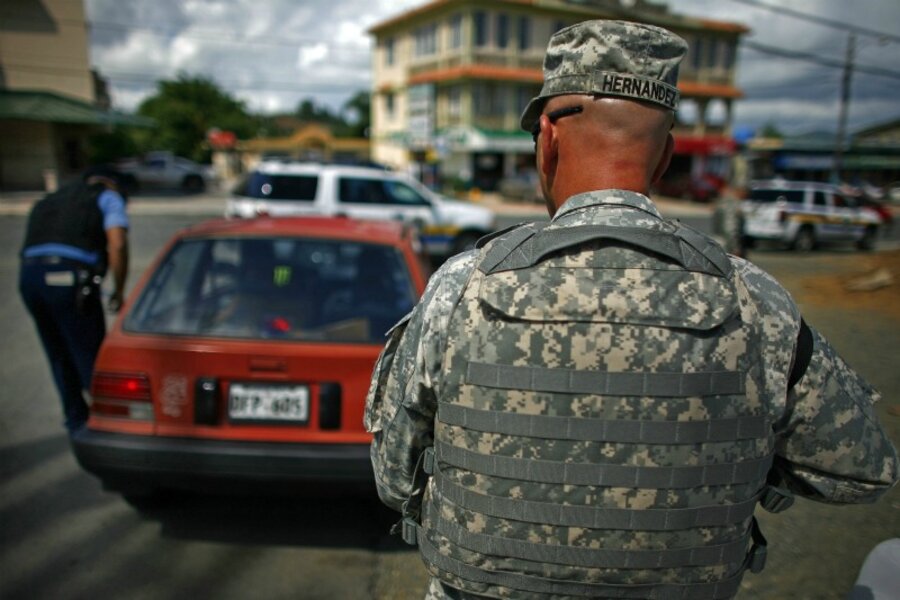As violent Puerto Rican drug trade seeps into mainland US, Washington must act
Loading...
| Washington
A fifteen-minute blast of automatic and semi-automatic weapons ushered in the New Year in Trujillo Alto, Puerto Rico, captured on a homemade video by cowering revelers. The incident brought to a close a year of brutal violence.
Drug trafficking is at the root of most of the 1,136 homicides perpetrated in Puerto Rico in 2011, the highest number ever recorded. While the US homicide rate dropped to a 40-year low in 2010, Puerto Rico’s rate peaked, exceeding even Mexico’s murder rate. The unmitigated demand for illegal drugs on the mainland US continues to fuel criminal violence on the Island.
The Puerto Rican government cannot manage this crisis alone. It has appealed to Secretary of Homeland Security Janet Napolitano, Attorney General Eric Holder, and Drug Czar Gil Kerlikowske for additional drug-fighting resources. Last week, Homeland Security Assistant Secretary Betsy Markey traveled to the Island, but no commitments have been made to date.
To the 3.7 million Americans living in Puerto Rico, Washington’s inaction on the violent Puerto Rican drug trade signals that federal protections afforded to US citizens do not fully convey outside the 50 states. The federal government must step up to the plate and ensure that all of its borders are secure and all of its citizens are safe.
As drug interdiction in the US-Mexico border has intensified, drug traffic has been redirected to Caribbean routes. While the Southwest border continues to be the primary entry point, Puerto Rico is the Caribbean gateway for cocaine and heroin entering the continental US. Once shipments reach Puerto Rico, mostly via the Dominican Republic, a portion is set aside for local consumption. The remainder, as high as 80 percent of the total in the case of cocaine, is directed to East Coast cities in continental US.
Over the past three years, federal agencies have noted an increase in drug and weapons seizures in Puerto Rico. The National Drug Intelligence Center reported a 76 percent increase in cocaine seizures in the Puerto Rico and US Virgin Island area between 2009 and 2010. A drop in cocaine prices between 2008 and 2010 in Puerto Rico suggests an increase in cocaine availability on the street.
In 2011, Puerto Rican cocaine rings operating in Connecticut, Massachusetts, and New York were shut down. In January, two Puerto Rican men were arrested in Boston’s Logan Airport smuggling $128,000 worth of cocaine. Days later, agents apprehended Dominican smugglers arriving by boat in Puerto Rico with 924 kilograms of cocaine with a street value of $60 million. Last week, another boat was intercepted off the west coast of Puerto Rico with a $4.9 million cocaine shipment.
San Juan is the fifth busiest port on the eastern seaboard, with traffic exceeding well over 1 million containers annually. It is a major transshipment point for cocaine and heroin, and only a minute fraction of the cargo is inspected. In 2010, less than 2 percent of the 14,321 containers inspected in Puerto Rico were checked for illegal drugs.
While cocaine and heroin traffic runs south to north, illegal profits travel in reverse. Drug profits primarily originating in Miami and New York are funneled through money laundering cells in Puerto Rico to Columbian narco-traffickers, much of it by way of the Dominican Republic. Puerto Rico’s cash-based economy – amounting to roughly $18 billion in cash retail sales in 2011 – facilitates laundering illegal profits.
As profits increase so do gang rivalries, which devolve into warfare whenever drug rings are decapitated. Last year’s conviction of Angelo Millones, a Puerto Rican trafficker with illicit earnings estimated at $100 million, sparked turf wars on the Island. This type of gang-on-gang violence has taken a toll on innocent bystanders, including children.
The recession also appears to have fueled drug-related violence, as figures for unemployment and criminal activity escalated in tandem. From March 2006 to 2011, unemployment rose from 9.2 to 16.9 percent. During this period homicides increased by roughly 52 percent.
Puerto Rico’s police, the second largest US force with approximately 17,000 officers, are overwhelmed and dispirited. Their integrity has been questioned by a Justice Department report citing constitutional violations, corruption, and statistical manipulations. In 2010, 89 local law enforcement officers were indicted and arrested on charges of trafficking and firearms crimes.
As the magnitude of the crisis grows, so does the necessity for Washington’s help.
The Puerto Rican representative in Congress is calling for a Caribbean Border Initiative akin to the Southwest Border Initiative which the Obama administration expanded in 2009. This multi-agency initiative (aimed at combating Mexican drug trafficking along the US border) has deployed manpower, technology, and resources to stem drug violence and flow. It includes $600 million in supplemental funds. An additional $1.6 billion have been appropriated for the Merida Initiative, a US-Mexico partnership to combat drug production and traffic in the region.
By comparison, Puerto Rico typically receives less than $50 million annually in direct federal funding for drug abuse prevention, investigations, prosecution, and interdiction. Federal law enforcement agencies operating in Puerto Rico are understaffed.
The Congressional Hispanic Caucus, Black Caucus, and Asian Pacific Caucus have asked President Obama to support the Caribbean Border Initiative and to confront what the Attorney General Eric Holder has called a national security issue.
Puerto Rico is in the frontline of the American war on drugs and it should be a priority in the national drug control policy. The island has an American coastline and an American citizenry that deserves the full protection of the federal government.
Gretchen Sierra-Zorita is project director of Media Diversity Initiatives at the National Hispanic Foundation for the Arts.







